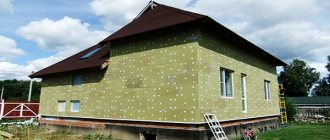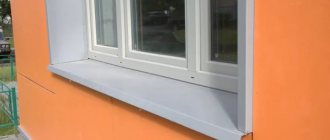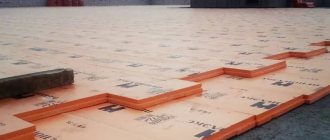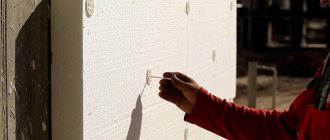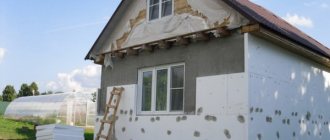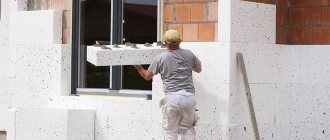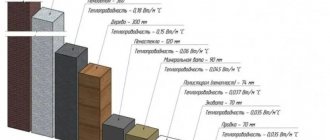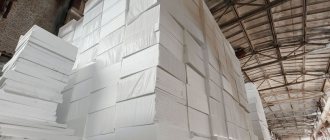Thermal insulation of the facade is a mandatory stage of installation work. The house will become energy efficient; heat will not escape through the walls. Thanks to this, heating costs will be reduced, and the house will be comfortable and cozy.
Mineral wool or polystyrene foam is often used as facade insulation. These materials are popular among homeowners. Let's try to understand how they differ.
First, let's figure out what these materials are.
Mineral wool is the name given to insulation materials made from molten minerals. The most popular options are basalt thermal insulation and quartz-based insulation. The first is made from molten basalt fibers, the second from a mixture of quartz sand, dolomite, limestone, soda, and borax.
Foam plastic is foamed plastic. In everyday life, foam plastic made from expanded polystyrene is usually used - this is what we will consider.
Let's compare thermal insulation made of mineral wool and polystyrene foam according to the following characteristics:
- Thermal conductivity.
- Vapor permeability.
- Fire resistance.
- Elasticity.
- Soundproofing.
- Environmental friendliness and safety.
- A light weight.
- Biostability.
- Chemical resistance.
- Mechanical strength.
- Easy installation.
- Stability of linear dimensions
Based on the comparison, we will conclude which insulation - mineral wool or polystyrene foam - is more profitable and practical.
Thermal conductivity
The main task of insulation is not to let heat out of the house. To do this, the material must have low thermal conductivity (the lower it is, the better).
Let's find out which has better thermal insulation: foam plastic or mineral wool.
Mineral wool has excellent thermal insulation qualities. Even in the harsh northern climate, it reliably protects your home from the cold.
Thermal conductivity of mineral wool is 0.035–0.039 W/(m*K). This indicator depends on the density of the material, so it may fluctuate slightly.
The thermal conductivity of expanded polystyrene is 0.037–0.042 W/(m*K), almost like mineral wool. Polystyrene foam effectively retains heat in the house.
Conclusion: foam plastic and mineral wool have similar thermal insulation properties. Both materials are characterized by low thermal conductivity.
Vapor permeability
This is the ability of a material to pass water vapor through itself or, conversely, to retain it. It is desirable that the insulation be vapor permeable. Then it will not be an obstacle to the steam leaving the room. For the façade to function properly, each subsequent “layer” must be more vapor-permeable than the previous one. For example, thermal insulation is installed on the facade. It is more vapor permeable than the material from which the walls are made. A breathable membrane is placed on the insulation, which is more vapor permeable than thermal insulation.
Mineral wool is a breathable insulation material. It does not create a barrier to the steam that escapes through the walls of the building. Excess moisture is removed outside and does not accumulate in the walls or insulation. This has a beneficial effect on the microclimate in the living space: the house will not be too humid. Condensation does not form under the insulation, the walls remain dry. Mineral wool is a good universal insulation material; it can be used to insulate facades made of any materials. With it, even wooden walls will not become damp.
Polystyrene foam (expanded polystyrene) practically does not breathe. When water vapor passes through the walls, it encounters an obstacle - foam insulation. An uncomfortable microclimate forms in the house, it becomes too humid. To normalize the humidity level, active ventilation must be provided, and this will lead to additional costs.
Polystyrene foam is not recommended for insulation of wooden houses - the facade underneath may become damp, and the wood may begin to rot. They can be used to thermally insulate walls made of reinforced concrete, aerated concrete, and brick. Such facades are not in danger of becoming damp. But in this case, steam that does not escape from the room can adversely affect the microclimate in the house.
Conclusion: mineral wool is vapor-permeable, foam plastic practically does not allow steam to pass through.
Mineral wool, widely used in our country for sound and heat insulation of premises, is not at all as harmless as it might seem at first, inexperienced glance. In fact, it is one of the most harmful building materials, second only to asbestos in terms of health hazards. Its fibers contain carcinogenic components, and the binding material is phenol-formaldehyde or melamine-formaldehyde resin, which releases highly toxic substances such as phenol and formaldehyde - essentially poisons for the human body. Research from the International Agency for Research on Cancer (IARC) confirms that fiber dust can cause cancer. In the USA and Europe, mortality rates among workers in factories producing fiberglass and mineral wool were studied. A significant portion of them died from lung cancer. The mechanism for developing the risk of diseases from mineral wool is as follows. Phenol is quickly absorbed into even intact areas of the skin of the human body. Almost immediately after entering the body, it begins to affect the brain and is capable of causing short-term excitation and paralysis of the respiratory center. Of course, modern mineral wool does not contain phenol in doses that cause an immediate effect, but even small proportions of this component cause a cough, headache, nausea, and loss of strength in humans. There is a delayed effect. More serious poisoning can lead to fainting, corneal insensitivity, seizures, and cancer. People who live for a long time near a source of phenol may have children with physical and mental disabilities. As for formaldehyde, according to some studies, mineral wool emits 0.02 mg of this component per square meter of its surface per hour. If we take into account the fact that in a residential area there are quite a lot of other sources of this highly toxic substance (chipboard, plywood, etc.), as well as its supply from street air, the maximum permissible concentration (0.05 mg/m³) of formaldehyde is exceeded several times! Mineral wool poses a particular threat to the respiratory system: dust from mineral fibers, entering the lungs and lingering there, can cause cancer. The degree of risk depends on the size and shape of the fibers. The most dangerous particles are those less than 3 microns thick and more than 5 microns long. By the way, this applies not only to mineral wool, but also to asbestos fiber, and to a lesser extent, fiberglass - sources of fine respirable dust that enters the respiratory tract and is not pushed back by exhaled air flows. It is not surprising that the problem of the dangers of mineral wool used as insulation in the construction of residential and office premises is of serious concern in Western countries. Workers dealing with this insulation are required by safety regulations to use sealed protective clothing, including respirators, goggles and gloves. Many foreign environmentalists are strongly in favor of banning the production and use of mineral wool altogether. Just like at one time (2005) asbestos was banned in the European Union. Finally, in our country, although belatedly, officials sounded the alarm regarding the health hazards of mineral wool. The head of Rospotrebnadzor Gennady Onishchenko recently Fr. The head of Rospotrebnadzor emphasized that if elementary technology is violated in the production of mineral wool and construction regulations are violated, then the use of such materials can lead to very serious health consequences. At the same time, Gennady Onishchenko emphasized that there is no proper control over products in construction markets today. Therefore, buyers are left to their own devices and the risk associated with the purchase of mineral wool increases sharply. Deputy General Director Alexey Strakhov also spoke about the lack of control over the quality of building materials in a recent interview. The widespread use of glass wool and asbestos in construction during the Soviet period led to a significant increase in morbidity. “Today glass wool is being replaced by mineral wool, but the effect is the same. These materials cannot be used because they are carcinogenic! Dust from mineral wool, if frequently inhaled, causes cancer and other diseases in the human body. In addition, mineral wool releases phenol: it, like chipboard, uses phenolic resins. Today no one is monitoring this. And carcinogenic mineral wool is widely used in housing and office construction.” “The smaller the dust particles, the higher its allergenicity and the possibility of penetration into the respiratory system. Fine dust, i.e., consisting of the smallest microscopic particles, has particular allergenic activity,” explained Nadezhda Logina, candidate of medical sciences, allergist-immunologist, chief medical doctor. “This includes dust, the source of which can be, for example, asbestos and mineral wool, which are widely used in Russia as construction and insulation materials.” Candidate of Medical Sciences, pulmonologist, family doctor, associate professor of the 1st Moscow State Medical University named after. Sechenov Dmitry Vinogradov also expressed serious concerns. “For example, a house was renovated with mineral wool insulation, and after a while patients began to experience clinical manifestations,” commented Dmitry Vinogradov. – “Microparticles released over time during the destruction of mineral wool settle in the lungs and are allergens leading to the formation of diseases such as dermatoses, obstructive and chronic bronchitis, bronchial asthma and others. Bacterial and fungal infections may be superimposed on this background. Recent studies confirm that the development of cancer is also possible.” “Society suffers losses due to the fact that we pay very little attention to environmental factors, including those inside the home, that adversely affect our health. 20% of married couples in the country are infertile, 10-15% of births are premature, the number of defects in newborns and perinatal mortality is growing,” explains Evgeniy Zharov, Doctor of Medical Sciences, professor, gynecologist, specialist in reproductive health, leading researcher at the Central Clinical Hospital of the Russian Academy of Sciences. According to Zharov, very toxic phenol is found in small doses in some medicines, even green tea and cosmetics. But with prolonged exposure, it accumulates in the body and can lead to the most disastrous consequences. “When ‘phenolic’ houses were built, it was hoped that the next generation would live under communism in new houses, but in reality, many people still live in housing that is hazardous to their health, including in Moscow,” Zharov said. – “Phenols, dirt, dust strike the microecology of the human body, destroying beneficial microorganisms. The biocenosis is disrupted, and as a result, numerous inflammatory processes occur. Moreover, these tiny particles can be absorbed not only through the respiratory tract, mucous membrane, but also through the skin.” Environmentalists also joined the position of doctors. “Phenols and formaldehydes are the strongest carcinogens that cause malignant neoplasms and tumors,” said Sergey Avdeev, executive director of OEO Green Wave. Environmental activists have already announced their intention to conduct a series of quality checks of mineral wool insulation, which are used during major repairs in Moscow.
Fire resistance
People's lives may depend on how resistant the material is to fire. Ideally, if the insulation is fire-resistant, then in the event of a fire it will not become an additional source of flame.
The flammability class of mineral wool is NG (non-combustible material) . This fireproof insulation effectively protects the house from fire. It is often used for the construction of fire barriers.
Even if you try to set fire to mineral wool, it will not catch fire. Its fibers can melt at temperatures above 1000 °C, but even in this case the insulation practically does not smoke and does not emit toxic compounds.
Polystyrene foam can ignite and sustain combustion. In the event of a fire, it can become a large source of fire. May release toxic substances when burned.
Polystyrene foam can be ordinary or self-extinguishing, modified with fire retardants - additives that increase fire resistance. The first one can burn on its own, even if the source of fire is eliminated. The second one does not burn on its own - if there is no source of flame, it goes out. Depending on the type of foam, the flammability group may vary - G4, G1, etc. But even self-extinguishing polystyrene foam can smoke and actively release toxic substances while it burns or smolders.
Polystyrene foam can transmit fire to surrounding flammable surfaces, such as wooden walls. This means that new fires may appear.
Conclusion: mineral wool is fire-resistant, polystyrene foam can burn and release toxic substances.
Where does the carbon footprint lead?
Unfortunately, 8 billion people cannot completely avoid environmental pollution. However, it is quite possible to reduce the overall burden and make life easier for both yourself and other species. Therefore, to assess such a load, an objective tool has been developed - the “carbon footprint”, which is easy to quantify and which helps to assess the potential damage to Nature from any human action.
A lot of attention is paid to reducing carbon emissions. “We have committed to achieving net-zero carbon emissions by 2050,” says Saint-Gobain President Pierre-André de Chalendar.
The concept of “carbon footprint” (aka “carbon footprint”) was proposed in 1992 by environmental scientist William Rees: it is “the totality of all greenhouse gas emissions produced directly and indirectly by an individual over his lifetime or during the production, use and disposal of any product.” . The calculation is based on CO2, since it is the main contributor to the total amount of greenhouse gases emitted, which affect the rate of global climate change. The relationship here is the opposite - the larger the footprint, the worse it is for the environment.
Obviously, from a carbon footprint perspective, the longer an item lasts and the easier it is to recycle or dispose of it in an environmentally friendly manner, the more environmentally friendly it is. On the other hand, the lower the cost of maintaining the standard of daily living, the lower the emissions (and, again, the higher the environmental friendliness). Thus, the principles of minimizing the carbon footprint, as applied to everyday life, can be formulated as follows:
- the use of durable items that are recyclable and have minimal impact on humans (for example, hypoallergenic mineral wool insulation);
- minimizing “habitual” emissions of pollutants (heat, sound, wastewater).
To implement this, the ideas of “passive buildings” have been actively developed in the world for half a century—houses that can save such an amount of internal heat (generated by people, household appliances, etc.) that they practically do not need additional heating. The carbon footprint, thanks to the use of environmentally friendly insulation for walls, floors, and roofs, is minimal.
Elasticity
Plasticity is an additional advantage of the material. Elastic insulation can be mounted on uneven walls and on complex-shaped facades.
Mineral wool is characterized by high plasticity. Loose flexible material takes the shape of any surface. If we compare basalt wool and quartz-based thermal insulation, the second is more flexible. Mineral wool is especially elastic in rolls, not in slabs - they are denser and stiffer.
Polystyrene foam is not elastic; it is rarely used for insulating facades of complex shapes. It is suitable for thermal insulation of a flat, even surface (if there are uneven surfaces on the wall, the insulation will not fit tightly to it).
Conclusion: mineral wool is elastic, foam plastic is not.
Soundproofing
This is not the main function of the insulation, but an additional bonus. If the material absorbs outside noise, the house will be quiet and comfortable.
Mineral wool provides excellent sound insulation. This is due to the structure of the material: it consists of randomly located fibers. When a sound wave passes through the insulation, it becomes entangled between the fibers and goes out.
Foam can also protect against third-party sounds due to the cellular structure of the material. The sound wave fades as it passes through the "bubbles" of polystyrene foam.
Conclusion: both materials are effective sound insulators.
Environmental friendliness and safety
Insulation for residential buildings must be environmentally friendly and harmless.
Mineral wool is environmentally friendly - it is made from natural materials. During operation, it does not emit toxic or allergenic compounds.
Expanded polystyrene is a synthetic material. During operation, it can release a toxic substance - styrene. It can irritate mucous membranes and cause allergies. For this reason, polystyrene foam is rarely used for interior work - mainly for exterior work.
Conclusion: mineral wool is environmentally friendly and safe. Polystyrene foam may release styrene during operation.
Environmental friendliness of stone wool materials
Natural materials that have been used by humans since ancient times are considered the most environmentally friendly. Such materials are wood and stone. However, in modern construction, wood and stone in their pure form are not always suitable. Wood is not durable enough and is a fire hazard; stone in its pure form is also not suitable for building houses.
Since ancient times, man has learned to make artificial materials from stone - concrete, brick, glass. Such materials are practical, beautiful, and environmentally friendly. However, in order for the home to be warm, it is necessary to erect walls of great thickness, which makes construction costly, and the building turns out to be massive and with a small usable volume of premises.
It is now generally accepted that it is most advisable to use thermal insulation materials in construction, which have high thermal resistance and, with a small thickness, replace solid masonry in terms of thermal efficiency.
The modern construction market is replete with a variety of thermal insulation materials of various compositions. Many of them are made from organic polymers and are not always safe. Thus, thermal insulation based on polyurethane releases toxic substances isocyanates, and polystyrene foam releases styrene, which is a dangerous poison for humans. Moreover, the release of these substances occurs not only during heating, but also under normal conditions during the operation of the building.
A very dangerous substance is hexabromocyclododecane, which is a fire retardant in polystyrene foam, i.e. component that reduces flammability. The use of this substance has been recognized as dangerous by the European Chemicals Agency, which has determined that it is persistent, bioaccumulative and toxic.
Today, one of the most effective and environmentally friendly insulation materials is stone wool. This is a type of mineral wool produced from igneous rocks of the gabbro-basalt group. Stone wool has all the advantages of natural stone, such as durability, chemical resistance, lack of release of harmful substances, however, due to the fact that the finest fibers are intertwined and form many tiny pores, stone wool products have one of the lowest thermal conductivity coefficients.
Thermal insulation boards made of ECOVER stone (basalt) wool are produced using the most modern equipment from natural raw materials. Man-made waste, such as blast furnace slag, is not used to produce ECOVER materials, which significantly affects the quality and safety of the product. To impart high physical, mechanical and operational characteristics during production, a small amount of binders and modifying additives is introduced, in which the content of hazardous substances is minimal. At the heat treatment stage, these substances are almost completely removed.
Stone wool is recognized as the most environmentally friendly material. It protects well from heat and cold, is safe for health, and is recommended for use in residential premises, as well as children's and health care institutions. This is a non-flammable material that does not emit toxic gases. The high level of environmental safety of ECOVER products is confirmed by sanitary and epidemiological conclusions and an environmental certificate.
Biostability
The less the material is exposed to insects and rodents, the longer it can last.
Quartz-based thermal insulation and basalt insulation do not require additional treatment with insecticidal compounds. As a rule, they do not attract rodents and insects and do not grow mold.
Insects or fungi usually do not grow in polystyrene foam, since it is a synthetic material. But mice can gnaw on it - they sometimes sharpen their teeth on the insulation and make nests in it. If the foam is damaged by rodents, it can quickly deteriorate, become unusable and require replacement.
Conclusion: both materials are bioresistant, but mineral wool is considered less attractive to rodents.
What is “bad ecology”?
What this means today is intuitively understood by any person: dirty air, unhealthy food, bad materials. But the problem is not limited to harmful industrial emissions or landfills. There are at least 7 types of natural pollution that are difficult to localize and that significantly affect the quality of human life:
- sound pollution;
- thermal pollution;
- air pollution;
- water pollution;
- Soil pollution;
- light pollution;
- visual pollution.
And the presence of even one of the listed points already makes life unecological. Therefore, any methods that completely remove or, more simply, reduce the level of such pollution - reducing industrial and transport emissions, sound and heat insulation of buildings, the use of closed water cycles, etc. — provide an opportunity to reduce the harmful burden on the environment and increase the environmental friendliness of our existence, both locally and globally. It is important that this can be done, as they say, “here and now”: you do not need special skills and knowledge to sort garbage or choose environmentally friendly insulation for your dacha, making the house passive.
Chemical resistance
During installation or operation, alkalis, solvents, and acids may come into contact with the insulation. Thermal insulation must be immune to them.
Mineral wool is resistant to aggressive substances. This is the best option if the insulation will come into contact with solvents, acids, and alkalis.
Polystyrene foam may dissolve or melt when exposed to chemicals.
Conclusion: mineral wool is resistant to aggressive chemicals. Styrofoam can be destroyed if you drop solvent or alkali on it.
Mechanical strength
The material must withstand mechanical stress. Otherwise, it may “fail” during transportation or installation.
Mineral wool is difficult to break - this will require a lot of effort. The elastic material cannot be broken.
Polystyrene foam is considered more fragile; it can break under mechanical stress. This can make transportation and installation more difficult. You must be extremely careful, otherwise the insulation may crumble and become unusable.
Conclusion: mineral wool, as a rule, is more resistant to mechanical stress.
Easy installation
It is desirable that the installation is simple - then you can do it yourself. It will also take less time.
Mineral wool is easy to install; even a beginner can handle this task. The material lends itself well to cutting and is easy to install on the facade. The only caveat is that you must follow safety precautions. To prevent cotton wool fibers from getting on your skin, hair, or eyes, use a mask, gloves, or a protective suit. Do not inhale mineral wool dust.
From a technical point of view, no special skills are required to install polystyrene foam. But it must be carefully cut (the edges of the material may crumble) and installed. When installing foam sheets on the wall, we do not recommend pressing on them - they may break.
Conclusion: Both materials are easy to install, but foam usually requires more careful handling.
Stability of linear dimensions
The insulation should not shrink or change geometric dimensions. Otherwise, gaps may form at the joints, which will become “cold bridges.”
Mineral wool is resistant to temperature changes; it does not shrink or expand. Basalt insulation does not “shrink”. Mineral wool tolerates deformation well and quickly restores its original dimensions. When compressed, it becomes more dense, so it is used in systems that experience static loads.
Foam plastic, as a rule, does not shrink; it has virtually no thermal expansion. But it can break under mechanical stress. For this reason, it is not recommended to insulate facades that are under stress with polystyrene foam.
Conclusion: both insulation materials have stable geometric dimensions.
Content
- What is “bad ecology”?
- Let's make the world a better place together. Employee stories
- Where does the carbon footprint lead?
- How not to “inherit”: reducing emissions
Environmental friendliness is the main construction trend of the decade, and perhaps the century. But what is this in relation to our homes? Let's figure out what a carbon footprint is, why proper insulation is so important for climate preservation, and which insulation is the most environmentally friendly.
Let's sum it up
So, which insulation is better: polystyrene foam or mineral wool?
We compared both materials. We learned that the heat and sound insulation properties of mineral wool and foam insulation are similar.
Mineral wool is an environmentally friendly, harmless breathable insulation material. It will protect your home from cold and noise, and will become a barrier to fire in case of fire. It is easy to install and is resistant to physical and chemical influences. It has a wide range of applications - mineral wool is used to insulate facades made of any materials (wood, brick, etc.), roofs, and fireproof ceilings are made from it.
So which is better: thermal insulation made of mineral wool or expanded polystyrene? We recommend mineral wool. In the Metal Profile online store you will find insulation based on basalt and quartz from reliable manufacturers.
Let your home be warm and cozy!
Making the world a better place together
In general, the concept of “sustainable development”, which has become the basic philosophy for countries and leading manufacturing companies, is aimed at improving the quality of life of all humanity and its harmonious development, which is impossible without serious efforts by everyone.
For such a large European company, a world leader in creating a comfortable space for people to live, work and relax, which is included in the TOP 100 largest industrial corporations in the world, sustainable development is one of the basic values.
In addition to the fact that the company tries to carry out all production cycles as consciously as possible, from the search for raw materials to recycling, Saint-Gobain strives to make the principles of the “road map” generally accepted in the construction sector, to help everyone who uses environmentally friendly products realize that these principles can become key strategic growth driver. We all need to understand that to achieve our goals we need to take action every day to make the world a better place to live.
For example, this is how it works in the lives of Russian employees of Saint-Gobain. Vitaly Mitin, senior business controller, does this:
- donated old/unused items to an organization that collects and recycles them free of charge;
- turns off the water while brushing your teeth;
- Brings used batteries to the office - special collection boxes are installed there;
- sorts and separates waste: plastic, metal, paper, glass;
- uses LED lamps instead of conventional incandescent lamps.
His colleagues also share their ways to reduce the negative impact on nature. In addition to using reusable bags, reducing resource consumption and recycling, there are also non-trivial methods.
They use an aerator on the kitchen faucet, reducing water consumption by up to 50%, buy used children's toys and things, tell children that they need to save light, water, trees in order to take care of our planet, when going to the store they use reusable fabric bags (previously , every time I went to the store I bought a plastic bag - there were approximately 350 bags / year). “Periodically (1 time / 2 years) I remove 1-2 m3 of scrap wooden pallets from the factory. I use firewood to heat the bathhouse at the dacha, then I use the ash from the firewood to fertilize the plants that we grow in the garden, and I collect metal screws and nails from boards for further scrap metal.”
By the way, the general director of Saint-Gobain in Russia, Ukraine and the CIS countries, Antoine Peyrude, also attaches great importance to the issues of environmental conservation and sustainable development both in the work of the company and in his personal life: he abandoned his personal car and goes to work by car. metro to reduce emissions into the environment, and often volunteers himself, for example, participating in cleaning beaches from plastic waste.

